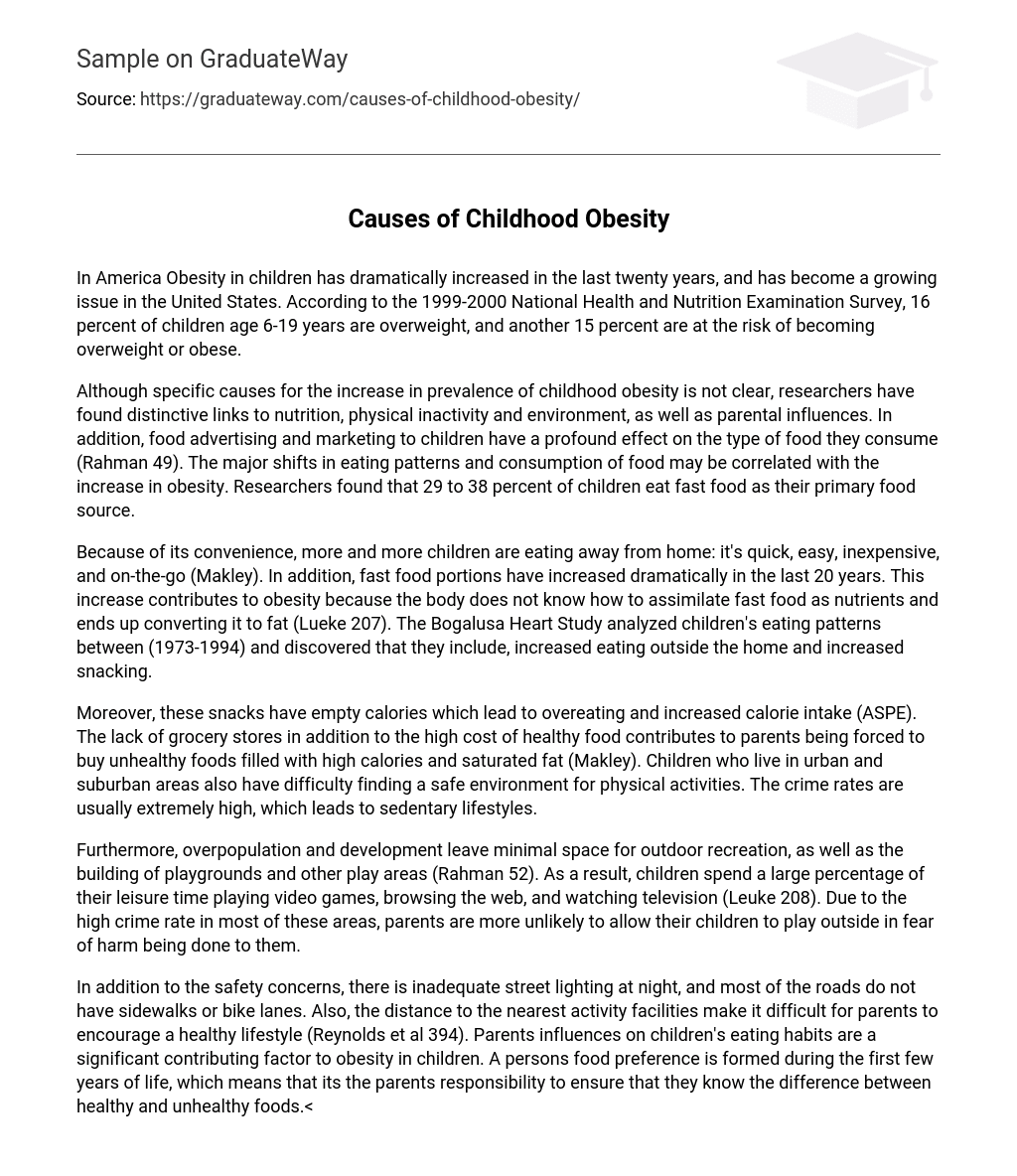In America Obesity in children has dramatically increased in the last twenty years, and has become a growing issue in the United States. According to the 1999-2000 National Health and Nutrition Examination Survey, 16 percent of children age 6-19 years are overweight, and another 15 percent are at the risk of becoming overweight or obese.
Although specific causes for the increase in prevalence of childhood obesity is not clear, researchers have found distinctive links to nutrition, physical inactivity and environment, as well as parental influences. In addition, food advertising and marketing to children have a profound effect on the type of food they consume (Rahman 49). The major shifts in eating patterns and consumption of food may be correlated with the increase in obesity. Researchers found that 29 to 38 percent of children eat fast food as their primary food source.
Because of its convenience, more and more children are eating away from home: it’s quick, easy, inexpensive, and on-the-go (Makley). In addition, fast food portions have increased dramatically in the last 20 years. This increase contributes to obesity because the body does not know how to assimilate fast food as nutrients and ends up converting it to fat (Lueke 207). The Bogalusa Heart Study analyzed children’s eating patterns between (1973-1994) and discovered that they include, increased eating outside the home and increased snacking.
Moreover, these snacks have empty calories which lead to overeating and increased calorie intake (ASPE). The lack of grocery stores in addition to the high cost of healthy food contributes to parents being forced to buy unhealthy foods filled with high calories and saturated fat (Makley). Children who live in urban and suburban areas also have difficulty finding a safe environment for physical activities. The crime rates are usually extremely high, which leads to sedentary lifestyles.
Furthermore, overpopulation and development leave minimal space for outdoor recreation, as well as the building of playgrounds and other play areas (Rahman 52). As a result, children spend a large percentage of their leisure time playing video games, browsing the web, and watching television (Leuke 208). Due to the high crime rate in most of these areas, parents are more unlikely to allow their children to play outside in fear of harm being done to them.
In addition to the safety concerns, there is inadequate street lighting at night, and most of the roads do not have sidewalks or bike lanes. Also, the distance to the nearest activity facilities make it difficult for parents to encourage a healthy lifestyle (Reynolds et al 394). Parents influences on children’s eating habits are a significant contributing factor to obesity in children. A persons food preference is formed during the first few years of life, which means that its the parents responsibility to ensure that they know the difference between healthy and unhealthy foods.
Also, parents should encourage their children to practice healthy eating habits such as; eating at the dining table rather than in front of the television, choosing fruits and vegetables during snack time at home, as well as during school hours at school. The eating environment that parents provide plays an equally important role in the child’s eating preferences. If a child is engaging in unhealthy eating habits, he or she is more likely to make poor food choices (Makley).
Researchers suggest that there is a link between exposure to food advertising and marketing, and obesity because such exposure affects the child’s food preferences, purchasing habits, as well as consumption (ASPE). Television advertisements influence food choices by enticing children to choose more sugary foods, and parents in turn purchase these products as a bribe to make the kids happy. Furthermore, marketing is not only on television, it’s also on other portable media devices such as cell phones and laptops. This makes children most vulnerable because there is little or no supervision, since they are usually away from home.
Studies find that television ads influence food consumption, because children are more likely to eat the popular products advertised because of their appealing graphics, slogan and music ( ASPE). Childhood obesity has become an epidemic in the United States. There are many components that play a role in this fact, however, nutrition, physical inactivity, environment and parental influences seems to be most obvious. Due to convenience, processed foods are replacing “fresh” in the diet, which results in high calorie diets and consequently increased weight leading to obesity (Makley).
Also, the percentage of children that walk to school has significantly dropped from 48 percent in 1969 to a low 13 percent in 2001 (Rahman 53). This may be directly be connected to the changes in the environment; more roads are being built without accessible and safe sidewalks, and crime rates are high, which makes the environment hazardous for children. These are critical issues that we, as a society, must address in order to ensure that our children are living a happy, healthy and productive lifestyle to secure a progressive transition into adulthood.





